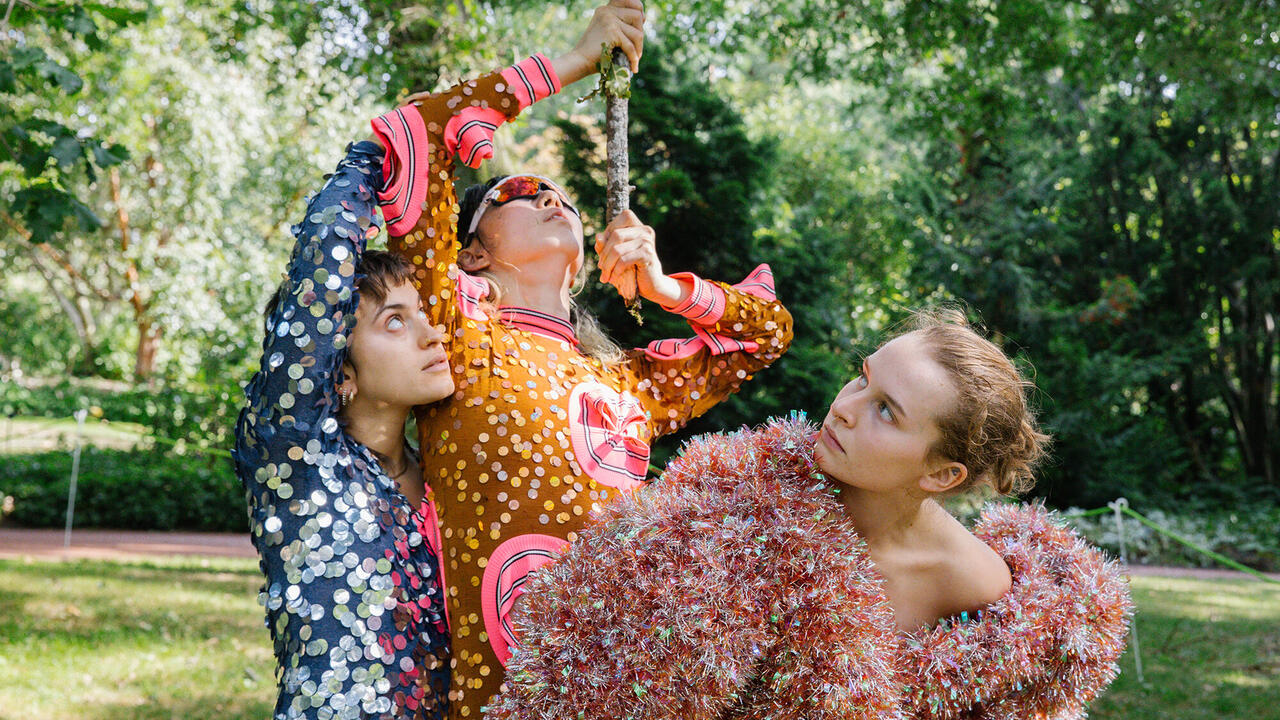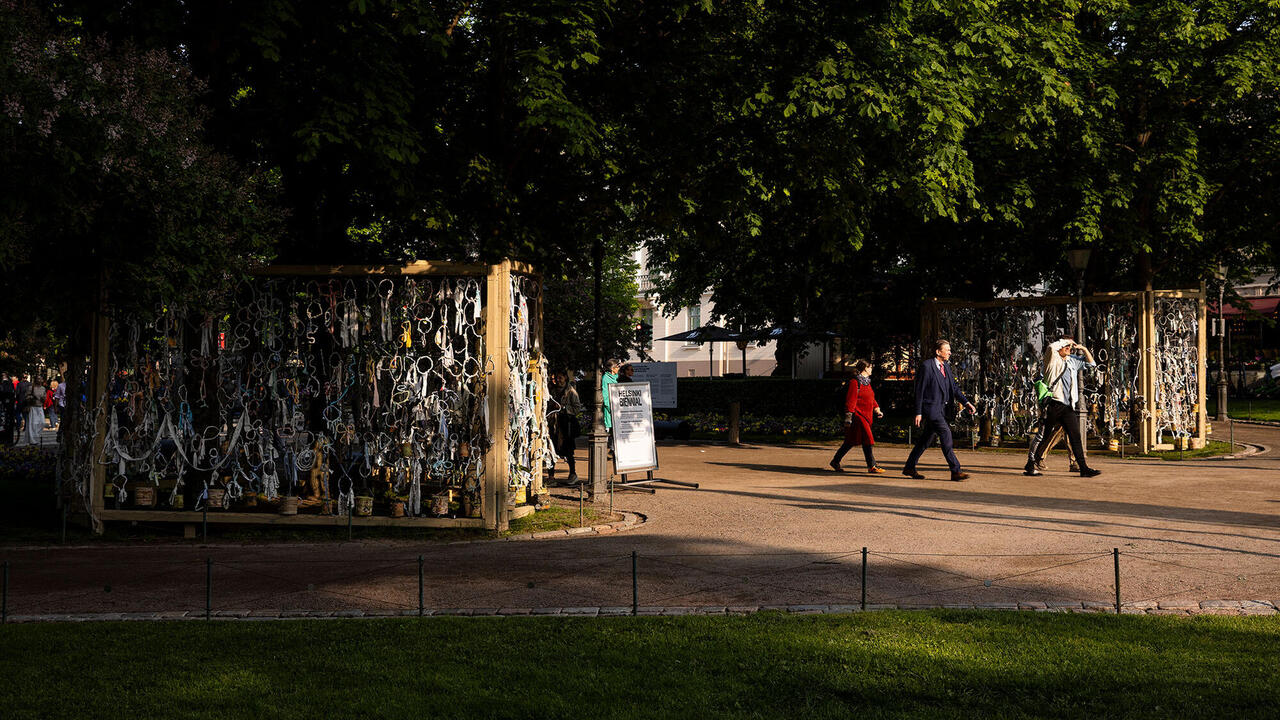This Will Have Been: Art, Love & Politics in the 1980s

Whether you experienced the decade as a protester or a passer-by, as a goth or a toddler, the 1980s perennially throws up a degraded copy of itself into our present moment. That era’s ghosts are on rerun, their dirges remixed and sampled for another go-round. These undead greeted visitors to ‘This Will Have Been: Art, Love & Politics in the 1980s’, a touring survey of art from that decade.
‘The End is Near’ announced the first of four thematic groupings, organized by curator Helen Molesworth: Gerhard Richter’s Skull (1983), David Salle’s Autopsy (1981), Martin Puryear’s tombstone-shaped Reliquary (1980) and Allan McCollum’s black decoy paintings (‘Plaster Surrogates’, 1982–91), among others, were propped like burial trophies in a pharaoh’s tomb, winking at the living. To enter through an endpoint introduced death as an aggressive hostess, eager for companions; to defy this seduction, and to get out of the ’80s alive, was deemed an urgent undertaking.
The notion of ‘a decade’ conveniently bookends a generation’s revolutions and regrets, but ‘This Will Have Been’ did not attempt to comprehensively catalogue the era, nor was it a greatest-hits selection. With around 90 artists and 130 objects, the exhibition presented the ’80s as a happening, an attitude, a swarm. Molesworth reformed our recent art history as an artist-activated corrective to misperceptions of gender and race, HIV/AIDS, the high Reagan-era in the US and the fall of communism abroad, especially as received secondhand from mass media and advertising outlets. The curatorial thesis pinned art as image activism – this was not a targeted social justice movement, but a battle fought for the public consciousness.
We already know what the ’80s looks like, but what did the objects of that decade accomplish? An answer came, in part, from outside the exhibition. Gran Fury’s 1989 poster, Kissing Doesn’t Kill, reappeared on Chicago’s streets aftera 20-plus-year absence. When it debuted in Chicago in 1990, its producers partly censored Gran Fury’s text to soften its condemnation of corporations – whose money was being wooed to fund research for a cure. Neutered, the billboard still baited haters: local legislators attempted to ban the image of the same-sex kissers, its message judged both obscene and obtuse. When Kissing Doesn’t Kill returned this year to Chicago’s streets, with its anti-corporate rhetoric fully restored, it served as an advertisement for this museum exhibition. Kissing Doesn’t Kill was already an ad once removed (its design mimicked the idiom of then-popular Benetton ads); now, piggybacked by an actual advertisement, it became a host transmitting a foreign body. This cycle of image transposition was exactly what many of the artists in ‘This Will Have Been’ were coming to terms with. The AIDS activists and the artists of the so-called Pictures Generation both challenged the ownership of meaning within publicly circulated images.
To counterfeit the American public image machine, artists retrofitted its technology with mock parts. Newspapers, logos, ads, talk shows and commercials, commodities, politicians and actors, were all subsumed into a parallel realism. By 1993 (the date of the latest work in the survey, by Gregg Bordowitz), with HIV/AIDS infection rates peaking, awareness of the epidemic was finally hitting home. That year, millions of people watched Tom Hanks play the role of a gay man with HIV defend his liberties in court, based on a true story, in Jonathan Demme’s film Philadelphia. Bordowitz also made a film that year, StrangeTrip, Long Drop, about his personal struggles with the infection and his outrage with its reception. Using the television production genres of newscasts and confessionals, Bordowitz’s work broadcast an accessible, and infuriating, message. ‘Aren’t we all living with AIDS?’ screamed the artist. ‘Isn’t this a crisis for all of us?’ The pandemic’s widespread grip was elsewhere performed in ‘This Will Have Been’ by General Idea’s AIDS Wallpaper (1989), a logo of the word ‘AIDS’ patterned in a nauseating palette, on top of which hung framed art works by Raymond Pettibon and Candy Jerrigan. Had the AIDS Wallpaper gone viral, and plastered the whitewashed gallery walls and crept under every art work in the exhibition, it would have been a powerful re-branding of history.
The pressures of American mass-cult lifestyle were bottled and fermented in two readymade ceramic vessels. Haim Steinbach’s display of ‘modern’ ceramic service-ware (Untitled [cabbage, pumpkin, pitchers] #1, 1986) was an unlikely but propitious counterpoint to Martin Kippenberger’s Put Your Freedom in the Corner, Save it for a Rainy Day (1990), including a shattered vessel reassembled with glue, behind a scaled-down replica of a Berlin Wall fragment covered with Robert Gober wallpaper. From opposite ends of the exhibition, the ceramic souvenirs embodied an anxious freedom – to consume, to prosper – and they beckoned, from afar, Warhol’s ceramic cookie jar collection, that storehouse of sublimated sexual gratification. (Warhol died in 1985 but his output from the ’80s was deemed irrelevant to this survey. However, he did show up, by proxy, in an oil portrait on black velvet by Julian Schnabel, wearing a bra and sporting a rash.)
Perhaps any large-scale group show is really a bricolage of its organizer’s tastes and politics (a lesson learnt, in fact, from the discourse of the ’80s), and for now the storyteller has spun a sensual and empowering tale from the centre of her experience, the fruits of which have been hard won. The past need not hurt as much coming back as it did going out. No culture war brewed here. With Andres Serrano and Karen Finley expunged, and Robert Mapplethorpe’s men as beautiful as ever, ‘This Will Have Been’ smoothed the sting from that controversy. This freed up space for an artist like Jimmy De Sana, the provocative photographer who died in 1990 at the age of 40 from AIDS. Here, his image was resurrected alongside the best of his generation’s self-portraits – by Cindy Sherman, Jimmie Durham, Nan Goldin, Jeff Wall and Leigh Bowery – in the ‘Gender Trouble’ section, forming a phalanx of image crusaders.
‘This Will Have Been’ mainly tethered its critique of mainstream culture to the familiar parade of museum-friendly, market-supported art objects. The show’s loosest foray into anti-art subculture came from G.B. Jones, whose lesbian erotica was culled from her punk zine, J.D.s. But Molesworth privileged the gallery-ready format, displaying Jones’s original pencil drawings rather than an old, fingered ’zine. Art history needs the type of beating that Jones’s S&M lesbians administer. By the time of the next inevitable revision of the 1980s, we’ll be primed to reach our hands into deeper, stranger memories.
















